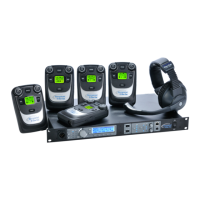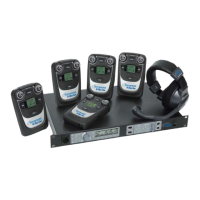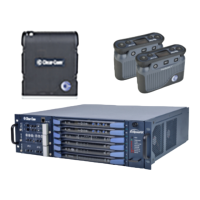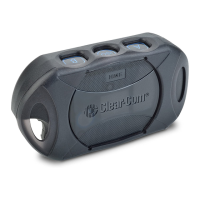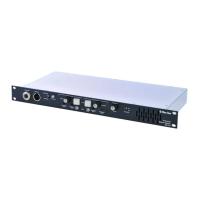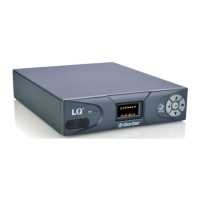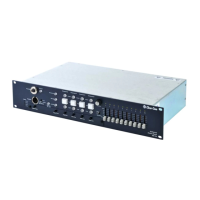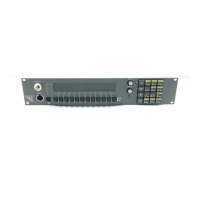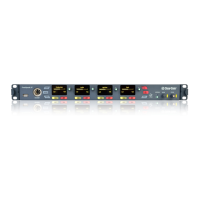8 www.clearcom.com
Theory of Operaon
Tempest uses Frequency Hopping Spread Spectrum (FHSS), Time Division Mulple Access (TDMA), and 2xTX technology. For example, on
Frequency 1 the BaseStaon and each BeltStaon take turns broadcasng, each with its own me slot to send audio data (TDMA). The total
me for one cycle is 5 milliseconds (1/200 second). The BaseStaon and all BeltStaons hop (FHSS) to a dierent predetermined frequency
and the same audio data is sent again, but on a new frequency and on a dierent BaseStaon antenna (2xTX). Therefore, each receiver has
two opportunies to receive the audio data. Duplicate data is discarded by the receiver and the process starts over with the next packet of
audio data.
Tempest is a DSP (Digital Signal Processor) based, full duplex, wireless intercom system. It is a digital, point-to-point
communicaons system, operang in 80MHz of spectrum in the 2.4GHz ISM frequency band. This band allows users to
operate with no license requirements in most locaons. The world-wide acceptance of the 2.4GHz band makes Tempest
ideal for traveling users.
The 2.4GHz band oers many benets. There are, however, a wide variety of technologies and users compeng for clear
spectrum in this limited band. Tempest ulizes patented and proprietary technologies to ensure a robust and reliable RF
link under a wide variety of physical and RF environments. This level of reliability is the most important aribute of any
wireless system.
Tempest ulizes proprietary, Frequency Hopping Spread Spectrum (FHSS) technology that has seven U.S. patents. Mulple
BeltStaon access is achieved by implemenng Time Domain Mulple Access (TDMA) with Frequency Shi Keying (FSK)
modulaon. Tempest uses an Algebraic Code - Excited Linear Predicon (A-CELP) voice compression algorithm to reduce the
bandwidth necessary for transmission and yet maintain the highest possible voice intelligibility. In addion, this algorithm
ulizes advanced lost packet masking technology, which greatly reduces the aect of packet loss, possible in all Digital RF
transmission schemes. The loss of audio packets is managed by the algorithm to reduce the possibility of detecng a loss
of audio.
In the 2.4GHz RF band mulpath interference occurs frequently. The Tempest RF scheme is dramacally enhanced with the
addion of proprietary 2xTX™ technology that transmits each data packet twice. This technique reduces spectral eciency
by half, but greatly increases audio intelligibility by reducing the Eecve Packet Error Rate (EPER) by orders of magnitude.
The system transmits packet data every 5ms and then “hops” or changes frequency. The sequence of frequency changes
is controlled by a predetermined hopping paern. Each hopping paern is opmized such that any new frequency has
a quasi-orthogonal relaonship to the last operang frequency. This quasi-orthogonal frequency relaonship ensures
maximum frequency separaon between any two consecuve hops. Because of this, if an interfering source is present in
one area of the operaonal band, and interferes on a parcular hop, the next hop will be in a clear area of the spectrum
with the best possible chance of transmission success.
With 2xTX technology, each audio packet is transmied twice, each on one of two consecuve hops. The loss of one packet
transmission in a harsh RF environment is common. However, because of the quasi-orthogonal frequency relaonship of
the consecuve redundant packet transmission, the potenal for loss of any single audio packet (2 consecuve data packet
transmissions) is dramacally reduced. In addion, each packet transmission is sent out from dierent antennas. This
unique approach enables Tempest to ulize spaal diversity, frequency diversity, me diversity and polarizaon diversity.
Transmission redundancy and the incorporaon of various diversity techniques provide an RF system that is robust and
reliable under greatly varying operaonal condions. Because of this inherent design, Tempest delivers superior operaonal
range and greater levels of interference and mulpath fade rejecon.
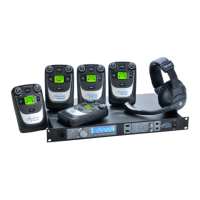
